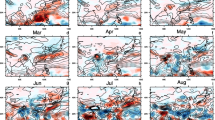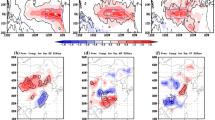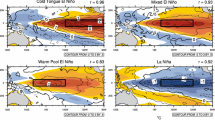Abstract
In this study, future change of El Niño-related East Asian (EA) rainfall and the diversity of this relationship are investigated on the basis of the historical and representative concentration pathway 8.5 (RCP 8.5) simulations taken from the Coupled Model Intercomparison Project phase 5 (CMIP5). By evaluating the East Asian Summer Monsoon (EASM) climatology and interannual variations in simulations contributing to CMIP5, nine models are verified to be capable of reproducing El Niño diversity and EASM simultaneously. Six of these models are selected for projecting the multi-model ensemble (MME) mean of two types of El Niño-related EA/western North Pacific (WNP) rainfall patterns and low-level atmospheric circulations under global warming, considering the realism in their simulated El Niño and EASM phenomena. It was found that, under a warmer background climate, the general patterns of anomalous circulation and rainfall will persist, but with amplification of the rainfall intensity during mature boreal winter and decaying summer for both Eastern-Pacific (EP) and Central-Pacific (CP) El Niño. Amplification of CP type-related rainfall seems to be stronger than that for EP type El Niño. Further analyses show that a moister atmosphere tends to always strengthen the rainfall variations for both El Niño flavors, regardless of how the El Niño-related circulation amplitude is modulated in various seasons. However, in boreal summer during the El Niño decaying phase, strengthened anomalous circulation also enhances the rainfall variability, with an effect comparable to the background moisture increase. Some of these atmospheric circulation changes might be associated with modified sea surface temperature anomalies (SSTA) of El Niño and its diversity, under global warming. Our results indicate the importance of better preparedness and higher resilience in the EA region to enhanced El Niño-induced hydrological variations under a warming climate.










Similar content being viewed by others
References
An KH, Tam CY, Park CK (2009) Improving the northeast Asian monsoon simulation: remote impact of tropical heating bias correction. Mon Weather Rev 137:797–803. https://doi.org/10.1175/2008MWR2612.1
Ashok K, Behera SK, Rao SA et al (2007) El Niño Modoki and its possible teleconnection. J Geophys Res. https://doi.org/10.1029/2006jc003798
Ashok K, Shamal M, Sahai AK, Swapna P (2017) Nonlinearities in the evolutional distinctions between El Niño and La Niña types. J Geophys Res Ocean 122:9649–9662. https://doi.org/10.1002/2017JC013129
Bayr T, Latif M, Dommenget D et al (2018) Mean-state dependence of ENSO atmospheric feedbacks in climate models. Clim Dyn 50:3171–3194.https://doi.org/10.1007/s00382-017-3799-2
Bonfils CJW, Santer BD, Phillips TJ et al (2015) Relative contributions of mean-state shifts and ENSO-driven variability to precipitation changes in a warming climate. J Clim 28:9997–10013. https://doi.org/10.1175/JCLI-D-15-0341.1
Chadwick R, Boutle I, Martin G (2013) Spatial patterns of precipitation change in CMIP5: why the rich do not get richer in the tropics. J Clim 26:3803–3822. https://doi.org/10.1175/JCLI-D-12-00543.1
Chen Z, Wen Z, Wu R et al (2013) Influence of two types of El Niños on the East Asian climate during boreal summer: a numerical study. Clim Dyn 43:469–481.https://doi.org/10.1007/s00382-013-1943-1
Chen L, Li T, Yu Y (2015) Causes of strengthening and weakening of ENSO amplitude under global warming in four CMIP5 models. J Clim 28:3250–3274.https://doi.org/10.1175/JCLI-D-14-00439.1
Chou C, Neelin JD, Chen CA, Tu JY (2009) Evaluating the “rich-get-richer” mechanism in tropical precipitation change under global warming. J Clim 22:1982–2005.https://doi.org/10.1175/2008JCLI2471.1
Collins M, An S-I, Cai W et al (2010) The impact of global warming on the tropical Pacific Ocean and El Nino. Nat Geosci 3:391–397.https://doi.org/10.1038/ngeo868
Endo H, Kitoh A (2014) Thermodynamic and dynamic effects on regional monsoon rainfall changes in a warmer climate. Geophys Res Lett 41:1704–1711.https://doi.org/10.1002/2013GL059158
Feng J, Wang L, Chen W (2014) How does the east asian summer monsoon behave in the decaying phase of El Niño during different PDO phases. J Clim 27:2682–2698.https://doi.org/10.1175/JCLI-D-13-00015.1
Ferrett S, Collins M, Ren H-L et al (2020) The role of tropical mean state biases in modelled winter northern hemisphere El Niño teleconnections. J Clim. https://doi.org/10.1175/jcli-d-19-0668.1
Gastineau G, Soden BJ (2009) Model projected changes of extreme wind events in response to global warming. Geophys Res Lett 36:1–5.https://doi.org/10.1029/2009GL037500
Held IM, Soden BJ (2006) Robust responses of the hydrologic cycle to global warming. J Clim 19:5686–5699.https://doi.org/10.1175/JCLI3990.1
Hsu PC, Li T, Luo JJ et al (2012) Increase of global monsoon area and precipitation under global warming: a robust signal? Geophys Res Lett 39:2–7. https://doi.org/10.1029/2012GL051037
Hsu PC, Li T, Murakami H, Kitoh A (2013) Future change of the global monsoon revealed from 19 CMIP5 models. J Geophys Res Atmos 118:1247–1260.https://doi.org/10.1002/jgrd.50145
Huang P, Xie SP (2015) Mechanisms of change in ENSO-induced tropical Pacific rainfall variability in a warming climate. Nat Geosci 8:922–926.https://doi.org/10.1038/ngeo2571
Huang B, Cubasch U, Kadow C (2018) Seasonal prediction skill of East Asian summer monsoon in CMIP5 models. Earth Syst Dyn 9:985–997.https://doi.org/10.5194/esd-9-985-2018
Huffman GJ, Adler RF, Bolvin DT, Gu G (2009) Improving the global precipitation record: GPCP Version 2.1. Geophys Res Lett 36:1–5.https://doi.org/10.1029/2009GL040000
Intergovernmental Panel on Climate Change (2014) Climate change 2013–-the physical science basis: working group I contribution to the fifth assessment report of the intergovernmental panel on climate change. Cambridge University Press, Cambridge
Jeong H-I, Lee DY, Ashok K et al (2012) Assessment of the APCC coupled MME suite in predicting the distinctive climate impacts of two flavors of ENSO during boreal winter. Clim Dyn 39:475–493.https://doi.org/10.1007/s00382-012-1359-3
Kalnay E, Kanamitsu M, Kistler R et al (1996) The NCEP/NCAR 40-year reanalysis project. Bull Am Meteorol Soc 77:437–471. https://doi.org/10.1175/1520-0477(1996)077<0437:TNYRP>2.0.CO;2
Kitoh A (2016) The Asian monsoon and its future change in climate models: a review. J Meteorol Soc Jpn Ser II 95:7–33. https://doi.org/10.2151/jmsj.2017-002
Kug J-S, Jin F-F, An S-I (2009) Two types of El Niño events: cold tongue El Niño and warm pool El Niño. J Clim 22:1499–1515. https://doi.org/10.1175/2008jcli2624.1
Kumar KK, Rajagopalan B, Hoerling M et al (2006) Unraveling the mystery of Indian Monsoon failure during El Niño. Science 314:115–119.https://doi.org/10.1126/science.1131152
Lau N-C, Nath MJ (2003) Atmosphere–Ocean variations in the Indo-Pacific sector during ENSO episodes. J Clim 16:3–20. https://doi.org/10.1175/1520-0442(2003)016<0003:AOVITI>2.0.CO;2
Lau N-C, Nath MJ (2009) A model investigation of the role of air–sea interaction in the climatological evolution and ENSO-related variability of the summer monsoon over the South China Sea and Western North Pacific. J Clim 22:4771–4792. https://doi.org/10.1175/2009JCLI2758.1
Lee J-Y, Wang B (2012) Future change of global monsoon in the CMIP5. Clim Dyn. https://doi.org/10.1007/s00382-012-1564-0
Lee RWK, Tam CY, Sohn SJ, Ahn JB (2017) Predictability of two types of El Niño and their climate impacts in boreal spring to summer in coupled models. Clim Dyn 89:1–17. https://doi.org/10.1007/s00382-017-4039-5
Li X, Ting M (2015) Recent and future changes in the Asian monsoon-ENSO relationship: natural or forced? Geophys Res Lett 42:3502–3512. https://doi.org/10.1002/2015GL063557
Li G, Xie SP (2014) Tropical biases in CMIP5 multimodel ensemble: the excessive equatorial Pacific cold tongue and double ITCZ problems. J Clim 27:1765–1780. https://doi.org/10.1175/JCLI-D-13-00337.1
Li G, Jian Y, Yang S et al (2019) Effect of excessive equatorial Pacific cold tongue bias on the El Niño-Northwest Pacific summer monsoon relationship in CMIP5 multi-model ensemble. Clim Dyn 52:6195–6212.https://doi.org/10.1007/s00382-018-4504-9
Li J, Wang B, Yang YM (2020) Diagnostic metrics for evaluating model simulations of the east asian monsoon. J Clim 33:1777–1801.https://doi.org/10.1175/JCLI-D-18-0808.1
Perry SJ, McGregor S, Gupta A, Sen, England MH (2017) Future changes to El Niño–Southern Oscillation temperature and precipitation teleconnections. Geophys Res Lett 44:10,608-610,616. https://doi.org/10.1002/2017GL074509
Power S, Delage F, Chung C et al (2013) Robust twenty-first-century projections of El Niño and related precipitation variability. Nature 502:541–545.https://doi.org/10.1038/nature12580
Rasmusson EM, Carpenter TH (1982) Variations in tropical sea surface temperature and surface wind fields associated with the Southern Oscillation/El Niño. Mon Weather Rev 110:354–384. https://doi.org/10.1175/1520-0493(1982)110<0354:vitsst>2.0.co;2
Rayner NA, Parker DE, Horton EB et al (2003) Global analyses of sea surface temperature, sea ice, and night marine air temperature since the late nineteenth century. J Geophys Res. https://doi.org/10.1029/2002jd002670
Ren HL, Jin FF (2011) Niño indices for two types of ENSO. Geophys Res Lett 38:2–6.https://doi.org/10.1029/2010GL046031
Roxy M, Patil N, Aparna K, Ashok K (2013) Revisiting the Indian summer monsoon-ENSO links in the IPCC AR4 projections: a cautionary outlook. Glob Planet Change 104:51–60. https://doi.org/10.1016/j.gloplacha.2013.02.003
Seager R, Naik N, Vecchi GA (2010) Thermodynamic and dynamic mechanisms for large-scale changes in the hydrological cycle in response to global warming. J Clim 23:4651–4668.https://doi.org/10.1175/2010JCLI3655.1
Sohn S-J, Tam C-Y, Jeong H-I (2016) How do the strength and type of ENSO affect SST predictability in coupled models. Sci Rep 6:33790.https://doi.org/10.1038/srep33790
Sohn S-J, Tam C-Y, Kug J-S (2019) How does ENSO diversity limit the skill of tropical Pacific precipitation forecasts in dynamical seasonal. predictions? Clim Dyn 53:5815–5831.https://doi.org/10.1007/s00382-019-04901-2
Song F, Zhou T (2014) The climatology and interannual variability of East Asian summer monsoon in CMIP5 coupled models: does air–sea coupling improve the simulations? J Clim 27:8761–8777. https://doi.org/10.1175/JCLI-D-14-00396.1
Sperber KR, Annamalai H, Kang IS et al (2013) The Asian summer monsoon: an intercomparison of CMIP5 vs. CMIP3 simulations of the late 20th century. Clim Dyn 41:2711–2744. https://doi.org/10.1007/s00382-012-1607-6
Stevenson SL (2012) Significant changes to ENSO strength and impacts in the twenty-first century: results from CMIP5. Geophys Res Lett 39:1–5. https://doi.org/10.1029/2012GL052759
Stevenson S, Fox-Kemper B, Jochum M (2012) Understanding the ENSO-CO2 link using stabilized climate simulations. J Clim 25:7917–7936.https://doi.org/10.1175/JCLI-D-11-00546.1
Taylor KE (2001) Summarizing multiple aspects of model performance in a single diagram. J Geophys Res 106:7183–7192.https://doi.org/10.1029/2000JD900719
Taylor KE, Stouffer RJ, Meehl GA (2012) An overview of CMIP5 and the experiment design. Bull Am Meteorol Soc 93:485–498.https://doi.org/10.1175/bams-d-11-00094.1
Tedeschi RG, Collins M (2016) The influence of ENSO on South American precipitation during austral summer and autumn in observations and models. Int J Climatol 36:618–635. https://doi.org/10.1002/joc.4371
Tedeschi RG, Collins M (2017) The influence of ENSO on South American precipitation: simulation and projection in CMIP5 models. Int J Climatol 37(8):3319–3339. https://doi.org/10.1002/joc.4919
Timmermann A, An SI, Kug JS et al (2018) El Niño–Southern Oscillation complexity. Nature 559:535–545
Todd A, Collins M, Lambert FH, Chadwick R (2017) Diagnosing ENSO and global warming tropical precipitation shifts using surface relative humidity and temperature. J Clim 31:1413–1433. https://doi.org/10.1175/JCLI-D-17-0354.1
Ueda H, Iwai A, Kuwako K, Hori ME (2006) Impact of anthropogenic forcing on the Asian summer monsoon as simulated by eight GCMs. Geophys Res Lett 33:20–23. https://doi.org/10.1029/2005GL025336
Vecchi GA, Soden BJ (2007) Global warming and the weakening of the tropical circulation. J Clim 20:4316–4340. https://doi.org/10.1175/JCLI4258.1
Wang B, Fan Z (1999) Choice of South Asian Summer Monsoon Indices. Bull Am Meteorol Soc 80:629–638. https://doi.org/10.1175/1520-0477(1999)080<0629:cosasm>2.0.co;2
Wang B, Wu Z, Li J et al (2008) How to measure the strength of the East Asian summer monsoon. J Clim 21:4449–4463. https://doi.org/10.1175/2008jcli2183.1
Wang B, Yim SY, Lee JY et al (2014) Future change of Asian–Australian monsoon under RCP 4.5 anthropogenic warming scenario. Clim Dyn 42:83–100. https://doi.org/10.1007/s00382-013-1769-x
Wang C, Deser C, Yu J-Y et al (2017) El Niño and Southern Oscillation (ENSO): a review. In: Glynn PW, Manzello DP, Enochs IC et al (eds) Coral reefs of the eastern tropical Pacific: persistence and loss in a dynamic environment. Springer, Dordrecht, pp 85–106
Wang Z, Li G, Yang S (2017) Origin of Indian summer monsoon rainfall biases in CMIP5 multimodel ensemble. Clim Dyn. https://doi.org/10.1007/s00382-017-3953-x
Wang P, Tam CY, Xu K (2019) El Niño–East Asian monsoon teleconnection and its diversity in CMIP5 models. Clim Dyn 53:6417–6435.https://doi.org/10.1007/s00382-019-04938-3
Watanabe M, Kamae Y, Kimoto M (2014) Robust increase of the equatorial Pacific rainfall and its variability in a warmed climate. Geophys Res Lett 41:3227–3232.https://doi.org/10.1002/2014gl059692
Weng H, Ashok K, Behera SK et al (2007) Impacts of recent El Niño Modoki on dry/wet conditions in the Pacific rim during boreal summer. Clim Dyn 29:113–129.https://doi.org/10.1007/s00382-007-0234-0
Weng H, Behera SK, Yamagata T (2009) Anomalous winter climate conditions in the Pacific rim during recent El Niño Modoki and El Niño events. Clim Dyn 32:663–674.https://doi.org/10.1007/s00382-008-0394-6
Wittenberg AT, Rosati A, Lau NC, Ploshay JJ (2006) GFDL’s CM2 global coupled climate models. Part III: Tropical Pacific climate and ENSO. J Clim 19:698–722.https://doi.org/10.1175/JCLI3631.1
Wu R, Hu Z-Z, Kirtman BP (2003) Evolution of ENSO-related rainfall anomalies in East Asia. J Clim 16:3742–3758. https://doi.org/10.1175/1520-0442(2003)016<3742:EOERAI>2.0.CO;2
Xie S-P, Deser C, Vecchi GA et al (2010) Global warming pattern formation: sea surface temperature and rainfall*. J Clim 23:966–986. https://doi.org/10.1175/2009JCLI3329.1
Xie SP, Deser C, Vecchi GA et al (2015) Towards predictive understanding of regional climate change. Nat Clim Change 5:921–930. https://doi.org/10.1038/nclimate2689
Xu K, Zhu C, He J (2012) Linkage between the dominant modes in Pacific subsurface ocean temperature and the two type ENSO events. Chin Sci Bull 57:3491–3496. https://doi.org/10.1007/s11434-012-5173-4
Xu K, Zhu C, He J (2013) Two types of El Niño-related Southern Oscillation and their different impacts on global land precipitation. Adv Atmos Sci 30:1743–1757. https://doi.org/10.1007/s00376-013-2272-3
Xu K, Huang RX, Wang W et al (2017a) Thermocline fluctuations in the equatorial Pacific related to the two types of El Niño events. J Clim 30:6611–6627. https://doi.org/10.1175/jcli-d-16-0291.1
Xu K, Tam C-Y, Zhu C et al (2017b) CMIP5 projections of two types of El Niño and their related tropical precipitation in the twenty-first century. J Clim 30:849–864. https://doi.org/10.1175/jcli-d-16-0413.1
Xu K, Huang QL, Tam CY et al (2019) Roles of tropical SST patterns during two types of ENSO in modulating wintertime rainfall over southern China. Clim Dyn 52:523–538.https://doi.org/10.1007/s00382-018-4170-y
Xu K, Tam C-Y, Liu B et al (2020) Attenuation of Central Pacific El Niño amplitude by North Pacific sea surface temperature anomalies. J Clim. https://doi.org/10.1175/jcli-d-19-0767.1
Yang S, Li Z, Yu J et al (2018) El Niño–Southern Oscillation and its impact in the changing climate. Natl Sci Rev 5:840–857. https://doi.org/10.1093/nsr/nwy046
Yeh S-W, Cai W, Min S-K et al (2018) ENSO atmospheric teleconnections and their response to greenhouse gas forcing. Rev Geophys.https://doi.org/10.1002/2017RG000568
Yu J-Y, Kim ST (2010) Three evolution patterns of Central-Pacific El Niño. Geophys Res Lett. https://doi.org/10.1029/2010gl042810
Yu J-Y, Zou Y (2013) The enhanced drying effect of Central-Pacific El Niño on US winter. Environ Res Lett 8:14019.https://doi.org/10.1088/1748-9326/8/1/014019
Yu J-Y, Kao P, Paek H et al (2015) Linking emergence of the Central Pacific El Niño to the Atlantic Multidecadal Oscillation. J Clim 28:651–662. https://doi.org/10.1175/jcli-d-14-00347.1
Yuan Y, Yang S (2012) Impacts of different types of El Niño on the East Asian climate: focus on ENSO cycles. J Clim 25:7702–7722. https://doi.org/10.1175/JCLI-D-11-00576.1
Zhou ZQ, Xie SP, Zheng XT et al (2014) Global warming-induced changes in El Niño teleconnections over the North Pacific and North America. J Clim 27:9050–9064. https://doi.org/10.1175/JCLI-D-14-00254.1
Acknowledgements
The World Climate Research Programme’s Working Group on Coupled Modelling, which is responsible for CMIP5, and the climate modeling groups are acknowledged. Helpful comments from Prof. Mat Collins and his research group, during PW’s visit at the Center of Exeter Climate Systems at the University of Exeter (supported by the Sino-British Fellowship Trust), are highly appreciated. This study is jointly supported by the National Natural Science Foundation of China (41776023 and 42076020), the Key Special Project for Introduced Talents Team of Southern Marine Science and Engineering Guangdong Laboratory (Guangzhou) (GML2019ZD0306), the Youth Innovation Promotion Association CAS (2020340), and the Rising Star Foundation of the SCSIO CAS (Grant no. NHXX2018WL0201). NCL at the Chinese University of Hong Kong is partially supported by the AXA Research Fund. The authors would also like to thank the anonymous reviewers for their valuable and constructive comments.
Author information
Authors and Affiliations
Corresponding author
Additional information
Publisher's Note
Springer Nature remains neutral with regard to jurisdictional claims in published maps and institutional affiliations.
Appendix: Moisture budget decomposition
Appendix: Moisture budget decomposition
For historical and future runs in each model, original values of monthly mean wind velocity and specific humidity during El Niño can be expressed as \(\overrightarrow{V}=\overrightarrow{{V}_{c}}+\overrightarrow{{V}^{{\prime }}}\) and \(q={q}_{c}+{q}^{{\prime }}\), respectively, where \(\overrightarrow{{V}_{c}}\) and \({q}_{c}\) denote their climatologies in each model, \(\overrightarrow{{V}^{{\prime }}}\) and \({q}^{{\prime }}\) represent the respective deviations due to El Niño from the corresponding climatology of each model. Thus, the moisture flux convergence in Eq. (1) can be expanded as:
The two terms, \(-\frac{1}{g{\rho }_{w}}\nabla \cdot {\int }_{{p}_{s}}^{{p}_{t}}\left({q}_{c}\overrightarrow{{V}^{{\prime }}}\right)dp\) (related to dynamic effect) and \(-\frac{1}{g{\rho }_{w}}\nabla \cdot {\int }_{{p}_{s}}^{{p}_{t}}\left({q}^{{\prime }}\overrightarrow{{V}_{c}}\right)dp\) (related to thermodynamic effect), are major contributors to the deviations of moisture flux convergence in the models, while the term by transient eddies \(\frac{1}{g{\rho }_{w}}\nabla \cdot {\int }_{{p}_{s}}^{{p}_{t}}\left({q}^{{\prime }}\overrightarrow{{V}^{{\prime }}}\right)dp\) is neglectable since both \({q}^{{\prime }}\) and \(\overrightarrow{{V}^{{\prime }}}\) are small deviations from their climatologies, and \(\frac{1}{g{\rho }_{w}}\nabla \cdot {\int }_{{p}_{s}}^{{p}_{t}}\left({q}_{c}\overrightarrow{{V}_{c}}\right)dp\) is stationary within the simulation period chosen. Finally, the El Niño-related anomalous moisture flux convergence can be expressed as:
Thus, we can have the anomalous moisture flux convergence and its dynamical and thermodynamical component for both types of El Niño under present and future scenarios. According to Eq. (4), the future changes of anomalous moisture transport can be approximated as:
To better understand how El Niño-related rainfall will be modified in a warmer climate, the perturbations of dynamical term (1st term on RHS) and thermodynamical term (2nd term on RHS) due to climate change can be further separated as follows:
and
Thus, Eq. (3) can be transformed as follows:
where \({\upvarphi }\left(\cdot \right)=\nabla \cdot {\int }_{{\text{P}}_{\text{s}}}^{{\text{P}}_{\text{t}}}\left(\cdot \right)\text{d}\text{p}\) is defined for simplicity and assume \(\hat{P}_{H}^{{\prime}}\) and \(\hat{P}_{F}^{{\prime}}\) are identical with each other. Thus, the relative contributions of the different moisture transport processes in determining the future changes of El Niño-related rainfall anomalies can be quantified and compared.
Rights and permissions
About this article
Cite this article
Wang, P., Tam, CY., Lau, NC. et al. Future impacts of two types of El Niño on East Asian rainfall based on CMIP5 model projections. Clim Dyn 56, 899–916 (2021). https://doi.org/10.1007/s00382-020-05510-0
Received:
Accepted:
Published:
Issue Date:
DOI: https://doi.org/10.1007/s00382-020-05510-0




